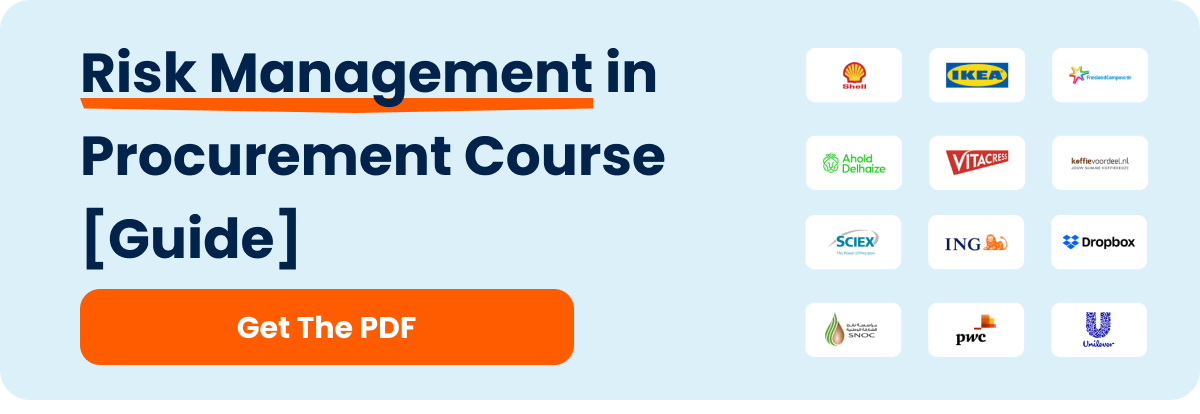Written by Marijn Overvest | Reviewed by Sjoerd Goedhart | Fact Checked by Ruud Emonds | Our editorial policy
Supply Chain Disruptions: How Vulnerable Is Your Organization?

As taught in the Supply Chain Basics for Procurement Professionals Course / ★★★★★ 4.9 rating
- Supply chain disruptions are unexpected events that disrupt the movement of goods, services, or information.
- Common supply chain disruptions are natural disasters, supplier issues, transportation delays, sudden changes in demand, cyberattacks, and geopolitical events, which can create delays and challenges.
- Supply chain disruptions can be avoided by assessing risks, diversifying suppliers, enhancing visibility across the supply chain, fostering collaboration, managing inventory carefully, and ensuring data security.
What are Supply Chain Disruptions?
Supply chain disruptions are unexpected events or obstacles that interrupt the usual flow of goods, services, or information within a supply chain.
These disruptions can occur anywhere from suppliers, manufacturers, distributors, and even customers.
They come in various forms and sizes, ranging from natural disasters and supplier bankruptcies to geopolitical conflicts and transportation delays.

Supply Chain Disruption Examples
Here are some common supply chain disruptions in the industry that you should watch out for.
1. Natural Disasters
Earthquakes, hurricanes, floods, and wildfires can affect deliveries, which results in delayed or canceled productions, ultimately causing adverse effects on supply and demand.
A recent example of this is the 2011 Japan earthquake and tsunami. It has affected the whole global economy as automotive manufacturers in Japan, such as Toyota and Nissan, temporarily shut down.
Effects of Natural Disasters
In Tohoku alone, the service industry was impacted the most, with 447 businesses facing bankruptcy. Hotels and inns were also hit with 125 bankruptcies. It brought the most disaster to supply chains and trade, as evidenced by the shutdown of Japan’s nuclear power reactors.
2. Supplier Issues
Supplier bankruptcies, quality problems, or sudden changes in their operations can disrupt the supply chain. This was the case that happened in 2019, with Forever 21’s bankruptcy.
The prominent fashion retailer sent shockwaves through its supply chain. Suppliers faced financial losses, and alternative arrangements had to be made swiftly.
Effects of Supplier Issues
In 2019, Forever 21 faced charges regarding labor practices regarding their workers’ pay and working conditions. Among these were their issues with their supplier, which resulted in several production delays, increased returns, and damage to the company’s reputation.
Due to supplier issues, customers were prompted to find new sources, often at a higher cost or lower quality, when suppliers went bankrupt.
3. Transportation Delays
Issues like port congestion, strikes, or fuel shortages can lead to delays in the transportation of goods.
The 2015 West Coast port labor strike in the United States is an example of this disruption. It resulted in significant delays in the movement of goods. It led to congestion at ports, backed-up shipments, and disruptions across various industries, affecting timely deliveries.
Effects of Transportation Delays
Transportation delays can result in increased operational costs because shipping fees are expedited to make up for them.
This is evidenced in the 2015 West Coast Port Labor Strike in the United States which lasted for about more than eight days and cost the whole economy about $8 billion. This transport strike not only damaged the economy, but also resulted in delays in the movement of goods. This places an additional burden on the part of the company as they would need to increase their operational costs due to such delays.
4. Demand Fluctuations
Unexpected shifts in customer demand, like the ones seen during the COVID-19 pandemic, can strain supply chains.
The COVID-19 pandemic caused sudden and unprecedented demand fluctuations. Industries like personal protective equipment (PPE) and healthcare experienced surges in demand. Whereas hospitality and travel saw a sharp decline. It’s challenging to match supply with rapidly changing demand patterns like this.
Effects of Demand Fluctuations
This led to too much inventory which increased holding costs, while stockouts can result in lost sales and dissatisfied customers. It can also make it difficult to maintain efficient production schedules when demand keeps on fluctuating.
5. Cyberattacks
Cybersecurity breaches can compromise data, disrupt operations, and lead to financial losses. We have seen this in the NotPetya cyberattack of 2017.
It initially targeted Ukraine but quickly spread globally, disrupting operations at several major companies.
Maersk, a global shipping giant, had its systems compromised, resulting in significant delays in cargo movement and financial losses. It can lead to unauthorized access to a lot of sensitive information, including private data, customer information, and financial records, which can decrease trust and potentially lead to legal consequences.
Effects of Cyberattacks
This led to a major billion-dollar loss on the part of Maersk. Tracking operations and logistics became offline during such time, leading to shipping delays. There were an estimated 50,000 endpoints that were affected, as well as over 600 sites in 130 countries. Aside from, this cyberattacks may cause financial strain on the part of the company due to the legal fines or ransom that may be demanded.
6. Geopolitical Factors
Aside from cyberattacks, geopolitical attacks like tariffs, trade disputes, and political instability in key regions can affect the movement of goods across borders.
Take, for example, the trade tensions between the United States and China in recent years. It led to tariff escalations and trade restrictions. This geopolitical dispute disrupted supply chains, forcing companies to reassess their manufacturing and sourcing strategies.
Effects of Geopolitical Factors
Geopolitical factors, such as those mentioned, can cause substantial changes to trade policies that can sometimes be bad for the company. This is because supply chains can also be left vulnerable due to geopolitical instabilities that can most likely lead to transportation delays and impact global supply chains.
For instance, the geopolitical dispute between the US and China in recent years led to tariff escalations and trade restrictions, leading to disrupted supply chains and even forcing some of the companies to reassess their sourcing strategies.

How to Prepare and Mitigate Risks from Supply Chain Disruptions
To bolster your organization’s resilience against supply chain disruptions, consider these steps:
1. Risk Assessment
Start by conducting a thorough risk assessment of your supply chain. This involves identifying and assessing vulnerabilities based on the likelihood of occurrence and their potential impact on your business.
By understanding these risks, you can prioritize them and develop proactive measures to ensure your supply chain continues to operate smoothly, even in the face of unexpected disruptions.
If your business relies heavily on a single overseas supplier for an important component and the supplier is located in an earthquake-prone region, a risk assessment would highlight the potential impact of earthquakes on your supply chain. This should prompt you to develop contingency plans.
2. Diversify Suppliers
Reduce your dependency on a single supplier by diversifying your supplier base. If possible work with multiple suppliers for important materials.
This way you’re spreading the risk. Having multiple suppliers for essential components ensures that production isn’t halted if one supplier faces issues.
If you work with a supplier based in a location prone to earthquakes or other natural disasters, it would be wise to collaborate with additional suppliers capable of providing the same supply of material.
This ensures that if any issues arise with the primary supplier, you can still obtain the materials from alternative sources.
3. Supply Chain Visibility
Invest in technology, such as advanced supply chain analytics and automation. These tools provide real-time visibility into your supply chain, enabling you to detect disruptions early.
With supply chain visibility tools, you can track the movement of goods and monitor various supply chain metrics. If a shipment encounters delays or disruptions, you can take real-time corrective actions to minimize the impact on your operations.
4. Collaboration
Foster open communication and collaboration with your suppliers and partners. Work together to develop contingency plans that outline how to respond to potential disruptions.
Collaborating with key suppliers allows you and your suppliers to plan for scenarios like transportation strikes together. By sharing information and resources, you can develop strategies to minimize downtime.
5. Inventory Management
Maintain strategic stockpiles of critical materials or components. These stockpiles act as a buffer against supply shortages during disruptions.
If you’re a manufacturer of medical devices, having a reserve of essential components can ensure continued production during unexpected supply interruptions.
6. Data Security
Strengthen your cybersecurity measures to protect sensitive supply chain data. Cyberattacks can disrupt operations and compromise vital information.
Implementing robust cybersecurity measures can safeguard your supply chain data from breaches that could disrupt communication and logistics.
Conclusion
Supply chain disruptions are a reality that organizations must face. By understanding the types of disruptions that can occur and taking proactive measures to prepare and mitigate risks, your organization can enhance its resilience and maintain the continuity of operations even in challenging times.
Frequentlyasked questions
How can I assess the vulnerability of my organization's supply chain?
Try to review your supply chain for weaknesses, like relying on one supplier or facing cybersecurity threats. Check if suppliers are financially stable. Plan how to deal with these risks and update your plan regularly.
Is there a one-size-fits-all solution for mitigating supply chain disruptions?
No. Risk mitigation should be tailored to an organization’s specific needs and situation.
What role does technology play in managing supply chain disruptions?
Technology offers real-time insights into supply chain operations, enabling businesses to identify disturbances early and help professionals take informed risk-reduction measures. Examples of this technology include data analytics and supply chain visibility tools.
About the author
My name is Marijn Overvest, I’m the founder of Procurement Tactics. I have a deep passion for procurement, and I’ve upskilled over 200 procurement teams from all over the world. When I’m not working, I love running and cycling.






